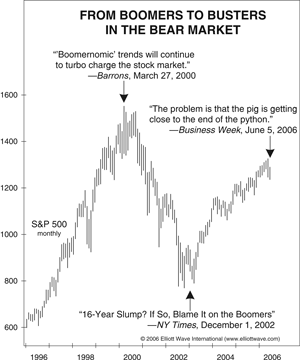
The news clips on this chart are representative of the transformation baby boomer’s retirement accounts have undergone since the all-time highs. Back in 2000 when the S&P was within a few points of its all-time high, “boomernomics” was slated to drive the market higher for years to come. The bear market changed all that, however. By late 2002, when most indexes were close to their lows for the bear market a whole new paradigm backed by some of the latest academic studies revealed that baby boomers were actually going to drive prices lower as they withdrew from the market to fund their retirements. Now after just one big tick down on this monthly chart, the ugly side of the baby boomer investment story is surfacing again. For those of you that have been rummaging around in the back issues of this site, this story about the “Gathering Pension Storm” probably sounds somewhat familiar. Sociotimes discussed the dark side of the pension story back in July and November of last year. In June of last year, EWFF explained why the tale of the pig and his python doesn’t turn out to have the happy ending so many have been holding out for. And here’s the full reference:
June 2005, EWFF
The conventional wisdom about the investment buying power of millions of baby boomers is on its way out — again. The Wall Street Journal reported earlier this month:
As Boomers Retire: Will Stock Prices Get Crushed?
The 1946-1964 baby boom = 1990-2008 investment boom equation dates to the start of the 1990s bull market extension when it was referred to us as the “Pig-in-python theory.” In 1998, as stocks were cresting, it was the subject of a second best-selling book. As EWFF noted in January 2003, The New York Times first re-cast boomers as “a force for the bear” with this headline: “16-Year Slump? If So, Blame It on the Boomers.” Why now? Because we are entering a large-degree third wave, which is the recognition phase. It is time for old bull market arguments to be refashioned into bear market arguments, as EWFF said they would be back at the all-time highs.
|
